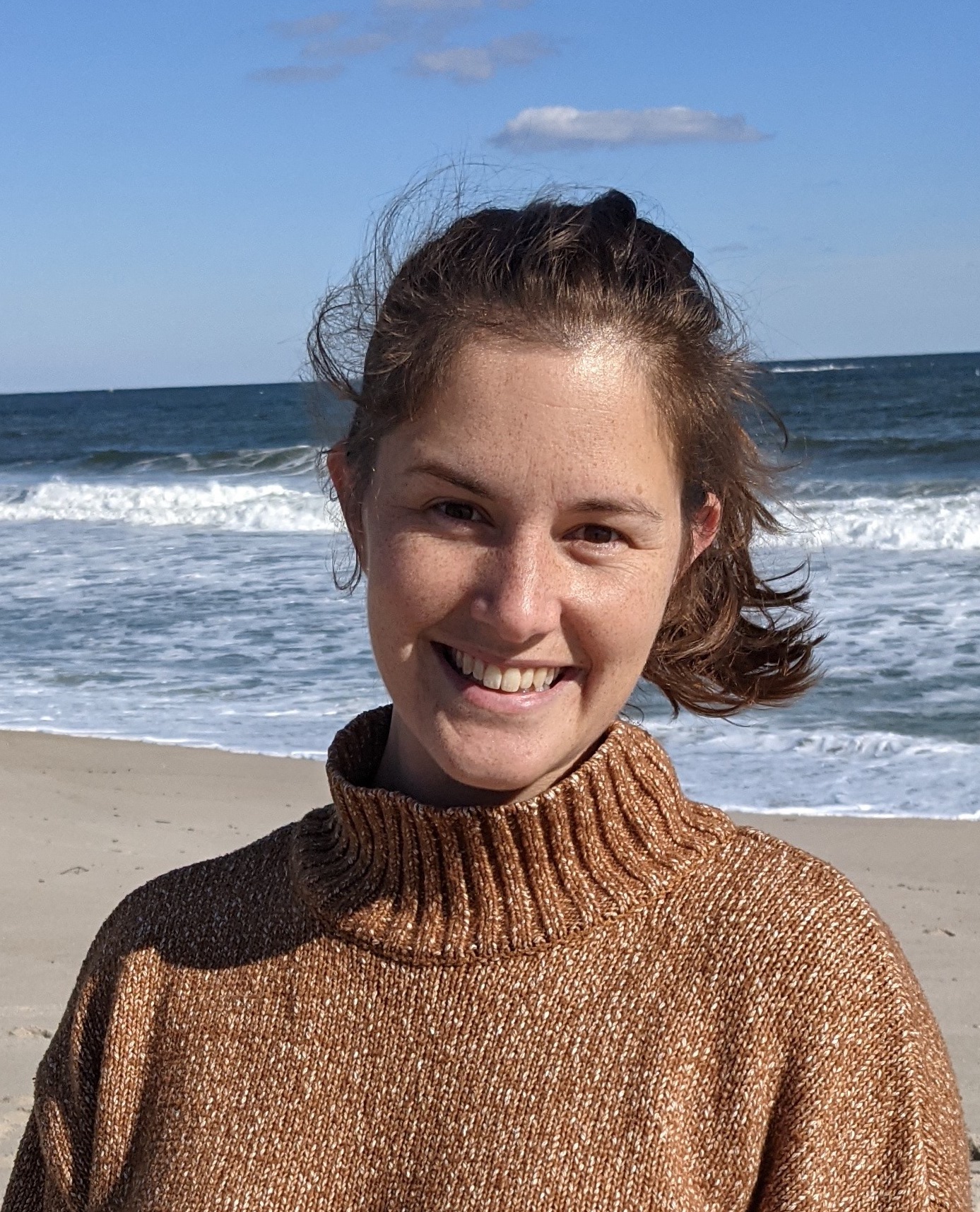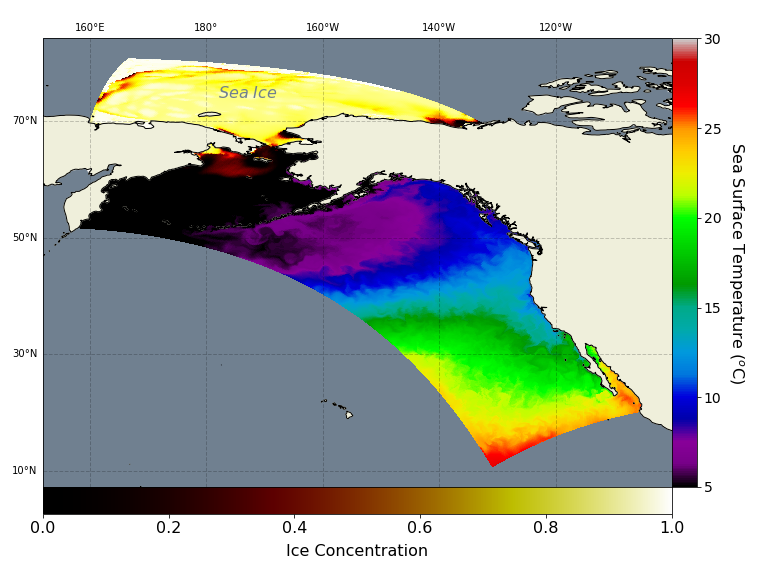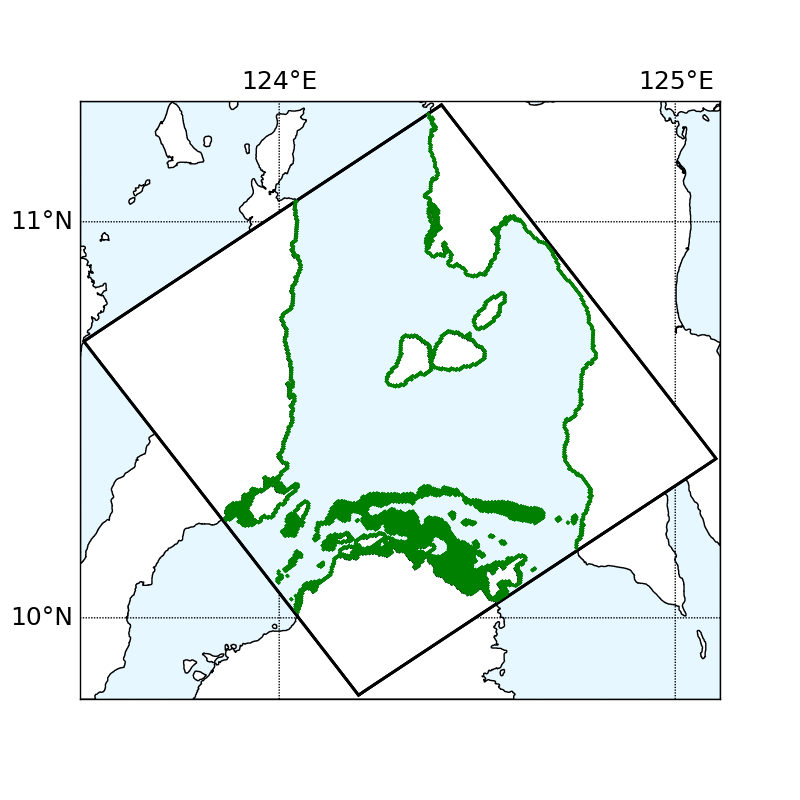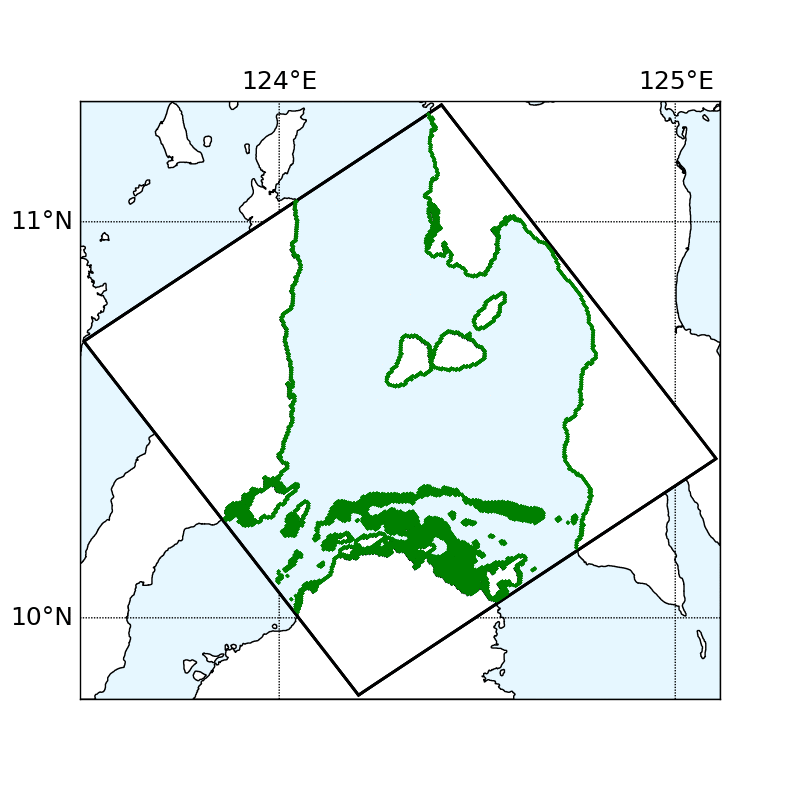Liz Drenkard
Research Interests
I study the response of ocean dynamics, ocean biogeochemistry and living marine resources to climate change and natural variability to derive implications for conservation and resource management.
Primary Research Activities
- Regional modeling (Modular Ocean Model 6; MOM6) of the North East Pacific Ocean
- Investigating the impacts of dynamic vs. static iron deposition on future ocean biogeochemistryCoauthors: Jasmin John, Charles Stock, Hyung-Gyu Lim, John Dunne, Paul Ginoux, and Jessica Luo
Other Research Interests and Collaborations
- Using GFDL’s ESM4 to predict Caribbean coral reef climate change refugia Collaborators: NOAA Hollings Scholar, Isabela Rios and Jessica Luo
- Quantifying eastern tropical Pacific shark species vulnerability to climate change Collaborators: Florencia Cerutti and Charles Stock
- Investigating environmental resilience of the Verde Island Passage to extreme heat events Collaborators: Raphael Dussin, Joanie Kleypas,Frederic Castruccio, and Enrique Curchitser
- Linking modeled (potential) and genetic (realized) clown fish larvae connectivity in the Camotes Sea Collaborators: Katrina Catalano, Malin Pinsky, and Enrique Curchitser
Education
- Ph.D., Climate Variability and Impacts, WHOI Joint Program in Oceanography, 2015
- B.A., Biological Sciences and Chemistry, Cornell University, 2009
Project Highlights
Regional Ocean Modeling: North East Pacific MOM6
The North East Pacific (NEP) is home to valuable fisheries and ecosystems rich in biodiversity. In support of
NOAA’s Climate and Fisheries Initiative, we are downscaling Earth System Models as a means of translating global climate information to relevant regional scales in service of management and conservation. The figure depicts the extent of our regional MOM6 NEP model domain, showing modeled sea ice concentration and sea surface temperature (spring 1981), which highlights representation of local currents and upwelling systems. This regional version of MOM6 was developed at GFDL in collaboration with
CIMES, and colleagues at Rutgers and University of Alaska, Fairbanks.
Dynamic vs. Static Iron Deposition in a Changing Climate
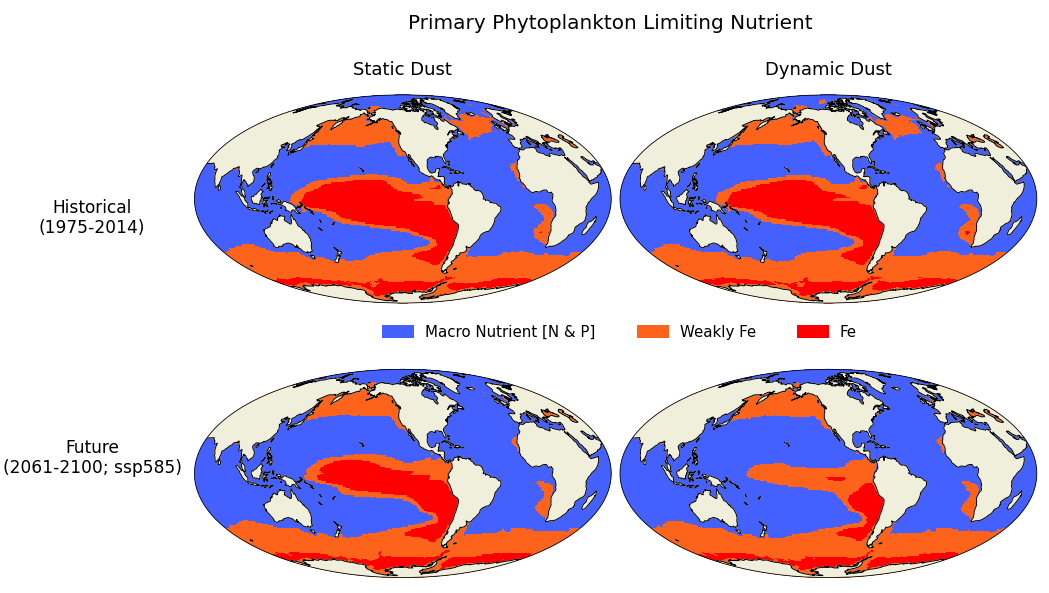
Airborne dust is an important source of iron to the upper ocean. The amount of dust transferred from air to sea (i.e., deposition) depends on a number of factors and can have important consequences for upper ocean biogeochemistry. However, until recently, iron deposition in most Earth system Models has been prescribed as a “static”, climatological flux that is not influenced by variability in factors such as precipitation or the amount of dust in the atmosphere. GFDL’s latest ESM4 contributions to CMIP6 include “dynamic” iron deposition (i.e., the flux reflects atmospheric conditions). In this work, we investigate how static vs. dynamic iron deposition affects projected future Pacific Ocean biogeochemistry. The figure shows the geographic distribution of the primary limiting nutrient for phytoplankton. Under future conditions (ssp585), dynamic iron deposition leads to a smaller area of iron limitation in the central Pacific with macronutrients (nitrogen and phosphorus) becoming more limiting by the end of the 21st century.
Lagrangian Particle Tracking: Studying Potential Connectivity
Planktonic larvae are at the mercy of ocean currents. While some float, others tend to migrate vertically exposing them to different horizontal velocity fields. Knowing where larvae may come from and end up is useful information for the design of marine protected areas. This work is conducted in collaboration with the Rutgers Earth System Modeling Group. This animation illustrates the difference in particle position (green markers; calculated using tracmass) over time when tracked at the surface (2D) vs. allowing particles to be moved vertically and horizontally (3D); region modeled: Camotes Sea, Philippines.
Recent Publications
- Liu, Xiao, John P Dunne, Elizabeth J Drenkard, and Gregory C Johnson, March 2025: Simulating Argo float trajectories and along-track physical and biogeochemical variability in the California Current System. Frontiers in Marine Science, 12, doi:10.3389/fmars.2025.1481761.
[ Abstract ]Trajectories of >1,600 virtual Argo profiling floats and their sampled variability in key ocean physical and biogeochemical variables are simulated using a 0.125° global ocean physical-biogeochemical model (NOAA GFDL’s MOM6-SIS2-COBALTv2) and an offline Lagrangian particle tracking algorithm. Virtual floats are deployed at 92 locations within 26-50°N, 114-132°W in the California Current System (CCS) during the summers and winters of 2008-2012 with varying sampling strategies adopted (e.g., floats are set to park and drift at different depths, and to profile at different intervals). The overall direction and spatial spreads of simulated float trajectories depend on the latitudes of deployment locations with the largest area and variability sampled by floats deployed in the central CCS. Floats drifting at shallower depths (200 m and 500 m) tend to sample larger variability associated with larger sampled area, while those drifting at 1000 m show the strongest association with eddy-like ocean features. Sensitivity experiments with varying sampling intervals suggest that spatiotemporal variability in float observables are adequately sampled with a typical 5-day or 10-day interval. Furthermore, simulated float trajectories and sampled variability are compared against 3 real float trajectories and along-track observations. Results suggest that the fidelity of both our model simulations and the prevalent Argo float sampling design are generally satisfactory in characterizing interior ocean biogeochemical variability. This study provides new insights to inform optimal float deployment planning, sampling strategies, and data interpretation.
- Catalano, Katrina A., Elizabeth J Drenkard, Enrique N Curchitser, Allison C Dedrick, Michelle R Stuart, Humberto R Montes Jr, and Malin L Pinsky, October 2024: The contribution of nearshore oceanography to temporal variation in larval dispersal. Ecology, 105(10), doi:10.1002/ecy.4412.
[ Abstract ]Patterns of population connectivity shape ecological and evolutionary phenomena from population persistence to local adaptation and can inform conservation strategy. Connectivity patterns emerge from the interaction of individual behavior with a complex and heterogeneous environment. Despite ample observation that dispersal patterns vary through time, the extent to which variation in the physical environment can explain emergent connectivity variation is not clear. Empirical studies of its contribution promise to illuminate a potential source of variability that shapes the dynamics of natural populations. We leveraged simultaneous direct dispersal observations and oceanographic transport simulations of the clownfish Amphiprion clarkii in the Camotes Sea, Philippines, to assess the contribution of oceanographic variability to emergent variation in connectivity. We found that time-varying oceanographic simulations on both annual and monsoonal timescales partly explained the observed dispersal patterns, suggesting that temporal variation in oceanographic transport shapes connectivity variation on these timescales. However, interannual variation in observed mean dispersal distance was nearly 10 times the expected variation from biophysical simulations, revealing that additional biotic and abiotic factors contribute to interannual connectivity variation. Simulated dispersal kernels also predicted a smaller scale of dispersal than the observations, supporting the hypothesis that undocumented abiotic factors and behaviors such as swimming and navigation enhance the probability of successful dispersal away from, as opposed to retention near, natal sites. Our findings highlight the potential for coincident observations and biophysical simulations to test dispersal hypotheses and the influence of temporal variability on metapopulation persistence, local adaptation, and other population processes.
- Cerutti-Pereyra, Florencia, Elizabeth J Drenkard, Mario Espinoza, Brittany Finucci, Felipe Galván-Magaña, Ana Hacohen-Domené, Alexander Hearn, Mauricio E Hoyos-Padilla, James T Ketchum, Paola A Mejía-Falla, Ana V Moya-Serrano, Andres F Navia, Diana A Pazmiño, Deni Ramírez-Macías, Jodie L Rummer, Pelayo Salinas-de-León, Oscar Sosa-Nishizaki, Charles A Stock, and Andrew Chin, July 2024: Vulnerability of Eastern Tropical Pacific chondrichthyan fish to climate change. Global Change Biology, 30(7), doi:10.1111/gcb.17373.
[ Abstract ]Climate change is an environmental emergency threatening species and ecosystems globally. Oceans have absorbed about 90% of anthropogenic heat and 20%–30% of the carbon emissions, resulting in ocean warming, acidification, deoxygenation, changes in ocean stratification and nutrient availability, and more severe extreme events. Given predictions of further changes, there is a critical need to understand how marine species will be affected. Here, we used an integrated risk assessment framework to evaluate the vulnerability of 132 chondrichthyans in the Eastern Tropical Pacific (ETP) to the impacts of climate change. Taking a precautionary view, we found that almost a quarter (23%) of the ETP chondrichthyan species evaluated were highly vulnerable to climate change, and much of the rest (76%) were moderately vulnerable. Most of the highly vulnerable species are batoids (77%), and a large proportion (90%) are coastal or pelagic species that use coastal habitats as nurseries. Six species of batoids were highly vulnerable in all three components of the assessment (exposure, sensitivity and adaptive capacity). This assessment indicates that coastal species, particularly those relying on inshore nursery areas are the most vulnerable to climate change. Ocean warming, in combination with acidification and potential deoxygenation, will likely have widespread effects on ETP chondrichthyan species, but coastal species may also contend with changes in freshwater inputs, salinity, and sea level rise. This climate-related vulnerability is compounded by other anthropogenic factors, such as overfishing and habitat degradation already occurring in the region. Mitigating the impacts of climate change on ETP chondrichthyans involves a range of approaches that include addressing habitat degradation, sustainability of exploitation, and species-specific actions may be required for species at higher risk. The assessment also highlighted the need to further understand climate change's impacts on key ETP habitats and processes and identified knowledge gaps on ETP chondrichthyan species.
- Olson, Elise M., Jasmin G John, John P Dunne, Charles A Stock, Elizabeth J Drenkard, and Adrienne J Sutton, July 2024: Site-specific multiple stressor assessments based on high frequency surface observations and an Earth system model. Earth and Space Science, 11(7), doi:10.1029/2023EA003357.
[ Abstract ]Global Earth system models are often enlisted to assess the impacts of climate variability and change on marine ecosystems. In this study, we compare high frequency (daily) outputs of potential ecosystem stressors, such as sea surface temperature and surface pH, and associated variables from an Earth system model (GFDL ESM4.1) with high frequency time series from a global network of moorings to directly assess the capacity of the model to resolve local biogeochemical variability on time scales from daily to interannual. Our analysis indicates variability in surface temperature is most consistent between ESM4.1 and observations, with a Pearson correlation coefficient of 0.93 and bias of 0.40°C, followed by variability in surface salinity. Physical variability is reproduced with greater accuracy than biogeochemical variability, and variability on seasonal and longer time scales is more consistent between the model and observations than higher frequency variability. At the same time, the well-resolved seasonal and longer timescale variability is a reasonably good predictor, in many cases, of the likelihood of extreme events. Despite limited model representation of high frequency variability, model and observation-based assessments of the fraction of days experiencing surface T-pH and T-Ωarag multistressor conditions show reasonable agreement, depending on the stressor combination and threshold definition. We also identify circumstances in which some errors could be reduced by accounting for model biases.
- Schultz, Cristina, John P Dunne, Xiao Liu, Elizabeth J Drenkard, and Brendan R Carter, February 2024: Characterizing subsurface oxygen variability in the California Current System (CCS) and its links to water mass distribution. Journal of Geophysical Research: Oceans, 129(2), doi:10.1029/2023JC020000.
[ Abstract ]The California current system (CCS) supports a wide array of ecosystem services with hypoxia historically occurring in near-bottom waters. Limited open ocean data coverage hinders the mechanistic understanding of CCS oxygen variability. By comparing three different models with varying horizontal resolutions, we found that dissolved oxygen (DO) anomalies in the CCS are propagated from shallower coastal areas to the deeper open ocean, where they are advected at a density and velocity consistent with basin-scale circulation. Since DO decreases have been linked to water mass redistribution in the CCS, we conduct a water mass analysis on two of the models and on biogeochemical Argo floats that sampled multiple seasonal cycles. We found that high variability in biogeochemical variables (DO and nutrients) seen in regions of low variability of temperature and salinity could be linked to water mass mixing, as some of the water masses considered had higher gradients in biogeochemical variables compared to physical variables. Additional DO observations are needed, therefore, to further understand circulation changes in the CCS. We suggest that increased DO sampling north of 35˚N and near the shelf break would benefit model initialization and skill assessment, as well as allow for better assessment of the role of equatorial waters in driving DO in the northern CCS.
- Barkan, Joel T., Jasmin G John, Elizabeth J Drenkard, and Drew Talley, December 2023: Ocean Discovery Institute’s model for empowering underrepresented students in STEM: Community-based, continuous belief. Oceanography, 36(4), doi:10.5670/oceanog.2024.117.
- Drenkard, Elizabeth J., Jasmin G John, Charles A Stock, Hyung-Gyu Lim, John P Dunne, Paul Ginoux, and Jessica Y Luo, November 2023: The importance of dynamic iron deposition in projecting climate change impacts on Pacific Ocean biogeochemistry. Geophysical Research Letters, 50(21), doi:10.1029/2022GL102058.
[ Abstract ]Deposition of mineral dust plays an important role in upper-ocean biogeochemical processes, particularly by delivering iron to iron-limited regions. Here we examine the impact of dynamically changing iron deposition on tropical Pacific Ocean biogeochemistry in fully coupled earth system model projections under several emissions scenarios. Projected end-of-21st-century increases in central tropical Pacific dust and iron deposition strengthen with increasing emissions/radiative forcing, and are aligned with projected soil moisture decreases in adjacent land areas and precipitation increases over the equatorial Pacific. Increased delivery of soluble iron results in a reduction in, and eastward contraction of, equatorial Pacific phytoplankton iron limitation and shifts primary production and particulate organic carbon flux projections relative to a high emissions projection (SSP5-8.5) wherein soluble iron deposition is prescribed as a static climatology. These results highlight modeling advances in representing coupled land-air-sea interactions to project basin-scale patterns of ocean biogeochemical change.
- Ross, Andrew C., Charles A Stock, Alistair Adcroft, Enrique N Curchitser, Robert Hallberg, Matthew J Harrison, Katherine Hedstrom, Niki Zadeh, Michael A Alexander, Wenhao Chen, Elizabeth J Drenkard, Hubert du Pontavice, Raphael Dussin, Fabien A Gomez, Jasmin G John, Dujuan Kang, Diane Lavoie, Laure Resplandy, Alizée Roobaert, Vincent S Saba, Sang-ik Shin, Samantha A Siedlecki, and James Simkins, November 2023: A high-resolution physical–biogeochemical model for marine resource applications in the northwest Atlantic (MOM6-COBALT-NWA12 v1.0). Geoscientific Model Development, 16(23), doi:10.5194/gmd-16-6943-20236943-6985.
[ Abstract ]We present the development and evaluation of MOM6-COBALT-NWA12 version 1.0, a 1/12∘ model of ocean dynamics and biogeochemistry in the northwest Atlantic Ocean. This model is built using the new regional capabilities in the MOM6 ocean model and is coupled with the Carbon, Ocean Biogeochemistry and Lower Trophics (COBALT) biogeochemical model and Sea Ice Simulator version-2 (SIS2) sea ice model. Our goal was to develop a model to provide information to support living-marine-resource applications across management time horizons from seasons to decades. To do this, we struck a balance between a broad, coastwide domain to simulate basin-scale variability and capture cross-boundary issues expected under climate change; a high enough spatial resolution to accurately simulate features like the Gulf Stream separation and advection of water masses through finer-scale coastal features; and the computational economy required to run the long simulations of multiple ensemble members that are needed to quantify prediction uncertainties and produce actionable information. We assess whether MOM6-COBALT-NWA12 is capable of supporting the intended applications by evaluating the model with three categories of metrics: basin-wide indicators of the model's performance, indicators of coastal ecosystem variability and the regional ocean features that drive it, and model run times and computational efficiency. Overall, both the basin-wide and the regional ecosystem-relevant indicators are simulated well by the model. Where notable model biases and errors are present in both types of indicator, they are mainly consistent with the challenges of accurately simulating the Gulf Stream separation, path, and variability: for example, the coastal ocean and shelf north of Cape Hatteras are too warm and salty and have minor biogeochemical biases. During model development, we identified a few model parameters that exerted a notable influence on the model solution, including the horizontal viscosity, mixed-layer restratification, and tidal self-attraction and loading, which we discuss briefly. The computational performance of the model is adequate to support running numerous long simulations, even with the inclusion of coupled biogeochemistry with 40 additional tracers. Overall, these results show that this first version of a regional MOM6 model for the northwest Atlantic Ocean is capable of efficiently and accurately simulating historical basin-wide and regional mean conditions and variability, laying the groundwork for future studies to analyze this variability in detail, develop and improve parameterizations and model components to better capture local ocean features, and develop predictions and projections of future conditions to support living-marine-resource applications across timescales.
- Drenkard, Elizabeth J., Charles A Stock, Andrew C Ross, Keith W Dixon, Alistair Adcroft, Michael A Alexander, V Balaji, Steven J Bograd, Momme Butenschön, Wei Cheng, Enrique N Curchitser, Emanuele Di Lorenzo, Raphael Dussin, Alan C Haynie, Matthew J Harrison, Albert Hermann, Anne B Hollowed, Kirstin Holsman, Jason Holt, Michael G Jacox, Chan Joo Jang, Kelly A Kearney, Barbara A Muhling, Mercedes Pozo Buil, Vincent S Saba, Anne Britt Sandø, Desiree Tommasi, and Muyin Wang, September 2021: Next-generation regional ocean projections for living marine resource management in a changing climate. ICES Journal of Marine Science, 78(6), doi:10.1093/icesjms/fsab100.
[ Abstract ]Efforts to manage living marine resources (LMRs) under climate change need projections of future ocean conditions, yet most global climate models (GCMs) poorly represent critical coastal habitats. GCM utility for LMR applications will increase with higher spatial resolution but obstacles including computational and data storage costs, obstinate regional biases, and formulations prioritizing global robustness over regional skill will persist. Downscaling can help address GCM limitations, but significant improvements are needed to robustly support LMR science and management. We synthesize past ocean downscaling efforts to suggest a protocol to achieve this goal. The protocol emphasizes LMR-driven design to ensure delivery of decision-relevant information. It prioritizes ensembles of downscaled projections spanning the range of ocean futures with durations long enough to capture climate change signals. This demands judicious resolution refinement, with pragmatic consideration for LMR-essential ocean features superseding theoretical investigation. Statistical downscaling can complement dynamical approaches in building these ensembles. Inconsistent use of bias correction indicates a need for objective best practices. Application of the suggested protocol should yield regional ocean projections that, with effective dissemination and translation to decision-relevant analytics, can robustly support LMR science and management under climate change.
- Kearney, Kelly A., Steven J Bograd, Elizabeth J Drenkard, Fabien A Gomez, Melissa A Haltuch, Albert Hermann, Michael G Jacox, Isaac C Kaplan, Stefan Koenigstein, and Jessica Y Luo, et al., August 2021: Using global-scale Earth system models for regional fisheries applications. Frontiers in Marine Science, doi:10.3389/fmars.2021.622206.
[ Abstract ]Climate change may impact ocean ecosystems through a number of mechanisms, including shifts in primary productivity or plankton community structure, ocean acidification, and deoxygenation. These processes can be simulated with global Earth system models (ESMs), which are increasingly being used in the context of fisheries management and other living marine resource (LMR) applications. However, projections of LMR-relevant metrics such as net primary production can vary widely between ESMs, even under identical climate scenarios. Therefore, the use of ESM should be accompanied by an understanding of the structural differences in the biogeochemical sub-models within ESMs that may give rise to these differences. This review article provides a brief overview of some of the most prominent differences among the most recent generation of ESM and how they are relevant to LMR application.
